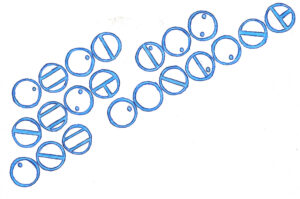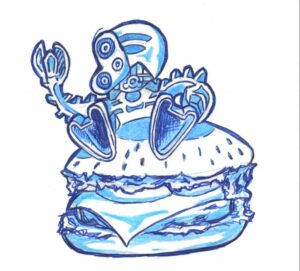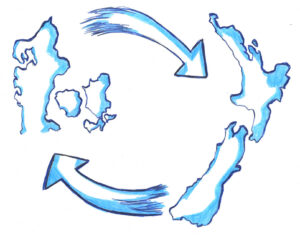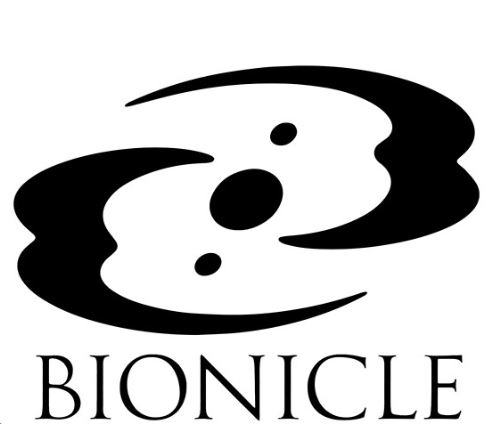Conlanging is the art of designing your own languages.
Bionicle is a franchise of buildable action figures produced by the Lego company from 2001 to 2010.
Te Reo Māori is a language in the Austronesian language family, and is spoken by approximately 186.000 people in New Zealand.
This is a story at the intersection of those three topics.
Part 1: Action Figures
I was born in 1995, so 2001 was the year I turned six. That places me just at the younger end of the intended demographic for Bionicle, the then-new line of action figures from the toy company Lego. In the years to come, these figures would take up a good deal of my attention, and several of my childhood memories are of playing out the stories of the elemental Toa, the wise Turaga, the brave Tohunga and the evil Makuta, in such exotic locations as (for example) the bookcase in my bedroom, magically transformed into an imposing cliff face on the tropical island of Mata Nui.
My favourite was Toa Tahu: The spirit of fire, and the first figure in a collection that would eventually span hundreds. I would buy as many of the toys as I was able to; at first using my parents’ money, and eventually using my own allowance (which is to say, my parents’ money but with extra steps). Every year, well over a dozen new characters were released, each with its own name, personality, powers and weaknesses, and its own role to play in a plot that would grow more convoluted for each successive wave of characters needing to be introduced.
This plot would be told across the folllowing decade through comics, movies, audioplays, books, video games and probably a whole bunch of apocrypha that I’m forgetting about. If the Bionicle movie trilogy were The Lord of the Rings, then my amassed knowledge of the franchise was the equivalent of having read The Silmarillion four times. In other words, I used to be a bit of a nerd (I know, who’d have guessed?).
Bionicle still holds a special place in the nostalgia chamber of my heart, but these days I mostly tend to spend my time on less niche things – such as attending meetings at SOLIA, my local society of language inventors. Since approximately one year ago, when we began meeting each Wednesday, conlanging has been one of the topics that never strays far from my mind. So when, a short while ago, I was reminded of the intricate Bionicle saga, it didn’t take long for the idea to pop up: Doesn’t a world like that deserve its own proper language?

Technically, there does already exist an official Bionicle ‘language’. In the stories and packagings, you’d see texts written in sequences of little circular signs filled with dots and lines. But any language enthusiast would quickly be able to tell that this wasn’t a real language, but rather a so-called cipher: A language that’s identical to English, only with each letter of the alphabet switched out with a different symbol. The system is ideal for writing hidden messages to set a ‘mystical’ mood, without being too difficult for kids to decipher. But it’s not a language. What it is, however, is a perfect excuse for a compulsive language inventor to build a conlang around.
Part 2: Te Reo Māori
A Bionicle conlang would have to be built around the body of language samples which already exist in the story: Place names, character names and cultural terms. For example, it’d be an obvious choice to make ‘Toa’ (the title worn by the heroes of the story) the word for ‘warrior’, and ‘Tahu’ (who, as mentioned above, is the Toa of fire) the word for ‘to burn’.
The problem with that is that there’s already a language in which those particular words mean those particular things. As it turns out, the majority of the names in the original cast of Bionicle characters are taken from Te Reo Māori – the language spoken by the Māori people of New Zealand. For a six-year-old in Denmark looking at a colourful plastic figure with a flaming sword, ‘Toa Tahu’ is simply a cool name (and to be honest, it still is for the twentyseven-year-old who used to be that six-year-old). But imagine being a native speaker of Te Reo Māori and being presented with an action figure basically called ‘burning warrior’… well, it’s really more of a basic description than a name, isn’t it?
To a portion of the Māori community, though, the Lego company’s use of these words came across as more than just unimaginative. The early years of the Bionicle story does not only use words from the language, but also draws heavy inspiration from the culture, religion and environment of the Māori. For instance, the story takes place on Mata Nui – an island which (discounting the fact that one-sixth of it is covered in ice) could easily have been situated in the tropic parts of the Pacific Ocean. For this reason, Danish newspapers would publish a series of articles throughout 2001 describing the case playing out between the Lego company and a group of representatives of the Māori people, who were raising alarms about the company’s commercial use of their language and culture. Among other things, they were unhappy with the fact that the name ‘Mata Nui’ (translating as ‘Great Face’, which is… interesting, to those familiar with the later chapters of the Bionicle story) was more-or-less obviously based on the real-life Pacific island of Rapa Nui – better known in English as Easter Island.
 The real issue, however, was the word ‘Tohunga’. In Te Reo Māori, the word ‘Tohunga’ refers to highly esteemed members of society: Religious leaders, different kinds of expert crafters, astronomers, weapon forgers and the likes. In other words, it’s a title that commands a significant level of respect. Lego, meanwhile, used the word as a name for their villagers in distress; existing mainly as someone for the heroes to save, and available for free with Happy Meals as an advertisement for the bigger toys.
The real issue, however, was the word ‘Tohunga’. In Te Reo Māori, the word ‘Tohunga’ refers to highly esteemed members of society: Religious leaders, different kinds of expert crafters, astronomers, weapon forgers and the likes. In other words, it’s a title that commands a significant level of respect. Lego, meanwhile, used the word as a name for their villagers in distress; existing mainly as someone for the heroes to save, and available for free with Happy Meals as an advertisement for the bigger toys.
But as it turned out, a fundamental misunderstanding was at play. In the original open letter addressed
to the Lego company, the Māori representatives demanded compensation for Lego’s attempt to copyright specific words from Te Reo Māori. The thing was: The company had not actually tried to copyright any Māori words in the first place, but only the name ‘Bionicle’ itself (which is a portmanteau of the English phrase ‘Biological Chronicle’). After a few months of writing back and forth, the misunderstanding was cleared up, and the parties had arrived at an agreement: Lego would cease to use certain cultural key words from the language, and would change the spelling of certain other names. That’s how Huki became Hewkii, Jala became Jaller, and the Tohunga people became the Matoran.
Part 3: Conlanging
 So how do you deal with that kind of circumstance from a storytelling perspective? The writers behind Bionicle chose to give the name changes an in-universe explanation by adding a ‘Naming Day’ into
So how do you deal with that kind of circumstance from a storytelling perspective? The writers behind Bionicle chose to give the name changes an in-universe explanation by adding a ‘Naming Day’ into
Tohunga – now Matoran – culture. This was a ceremony in which certain characters were celebrated for particular bravery by having the spelling of their names slightly changed.
That solution is not going to help a conlanger, though. Should you completely omit the Māori words from a hypothetical Bionicle-based conlang? That would be difficult, because some of the names remained in use, unchanged, throughout the entire run of the franchise; Tahu, for one, remained a main character for years to come. Should you omit only those words which Lego themselves agreed to omit? Maybe, but then the conlang would not reflect the world as it was supposed to – it’s a fact of the story that Jaller used to be called Jala.
And how do you even know whether using those words would be a problem to anyone? A conlang isn’t a commercial product, and it doesn’t involve claiming any copyrights. The obvious approach would be to ask the Māori themselves… but for a language with 186.000 speakers, how could anyone possibly have the authority to answer on behalf of them all? Perhaps the best thing to do would be to include all the words that have at some point been part of the Bionicle story, but to make it explicit where those words come from and in what context they were originally built into the setting. When you find yourself in a communicative dilemma, it’s often a good start to share all the available information in as accessible a manner as possible.
So there was my solution. I now had the concept of a Bionicle conlang clearly envisioned, ready to be added to the ever-growing pile of conlang ideas that I want to carry out but will probably never find the time for.
Luckily for the idea, I wasn’t the only one to have it. A cursory glance through the internet reveals that there already exists a conlanging project titled ‘The Matoran Language’. The project is available on a Tumblr blog, and is created by a Bionicle fan under the pseudonym outofgloom. The person’s real identity remains unrevealed, but they describe themselves as “PhD, teacher, linguist, LEGO/Bionicle enthusiast [and] a total nerd”.
On that blog, you’ll find a phrasebook, an etymological dictionary, and three successive editions of an increasingly detailed grammar of the Matoran language. If you download the 83-page PDF of the grammar, you’ll see something visually similar to a professional description of a real language, including academic references to fictional linguists of the Bionicle world. The grammar also contains a single out-of-character page describing the real-world relationship between the conlang and Te Reo Māori, as well as a glossary of what some of the borrowed words originally mean. To put it another way, this is just the project I had in mind – exactly as I had imagined it, and better than I could ever have done it. I don’t know exactly how well-known this conlang is among hardcore Bionicle fans, but I do know that it’s big enough for a yet another fan to have translated and recorded actual music in the language.
And that’s what motivated me to write this blog entry. Because I realised that my relationship with this toy franchise no longer just consisted of a nostalgic appreciation and a near-encyclopedic amount of lore information bubbling below the surface of my memory. It also consisted of some interesting stories about the franchise’s interactions with language. Both in the area of continously relevant questions about the interaction between language, culture and commercial enterprises; and also in the area of a language-related hobby which I know I share with at least a handful of Lingoblog’s readers.
If you’ve made it all the way to this point, I appreciate your getting all the way through my rant about the hunks of plastic that I used to play make-believe with as a kid. As far as I’m concerned, in doing so, you have exhibited the virtues that are held in so high esteem by Turaga Vakama and the Great Spirit Mata Nui himself: Unity, Duty, Destiny.
Gustav Styrbjørn Johannessen is an MA student of Linguistics at Aarhus University. He is currently writing his Master’s thesis about communicating linguistics to the broader public, and will be giving a talk at Sprogense 2023 on the role of language in mythological narratives.







